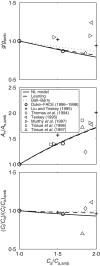A stomatal optimization theory to describe the effects of atmospheric CO2 on leaf photosynthesis and transpiration
- PMID: 19995810
- PMCID: PMC2826246
- DOI: 10.1093/aob/mcp292
A stomatal optimization theory to describe the effects of atmospheric CO2 on leaf photosynthesis and transpiration
Abstract
Background and aims: Global climate models predict decreases in leaf stomatal conductance and transpiration due to increases in atmospheric CO2. The consequences of these reductions are increases in soil moisture availability and continental scale run-off at decadal time-scales. Thus, a theory explaining the differential sensitivity of stomata to changing atmospheric CO2 and other environmental conditions must be identified. Here, these responses are investigated using optimality theory applied to stomatal conductance.
Methods: An analytical model for stomatal conductance is proposed based on: (a) Fickian mass transfer of CO2 and H2O through stomata; (b) a biochemical photosynthesis model that relates intercellular CO2 to net photosynthesis; and (c) a stomatal model based on optimization for maximizing carbon gains when water losses represent a cost. Comparisons between the optimization-based model and empirical relationships widely used in climate models were made using an extensive gas exchange dataset collected in a maturing pine (Pinus taeda) forest under ambient and enriched atmospheric CO2. Key Results and Conclusion In this interpretation, it is proposed that an individual leaf optimally and autonomously regulates stomatal opening on short-term (approx. 10-min time-scale) rather than on daily or longer time-scales. The derived equations are analytical with explicit expressions for conductance, photosynthesis and intercellular CO2, thereby making the approach useful for climate models. Using a gas exchange dataset collected in a pine forest, it is shown that (a) the cost of unit water loss lambda (a measure of marginal water-use efficiency) increases with atmospheric CO2; (b) the new formulation correctly predicts the condition under which CO2-enriched atmosphere will cause increasing assimilation and decreasing stomatal conductance.
Figures






References
-
- Aalto T, Hari P, Vesala T. Comparison of an optimal stomatal regulation model and a biochemical model in explaining CO2 exchange in field conditions. Silva Fennica. 2002;36:615–623.
-
- Ainsworth EA, Rogers A. The response of photosynthesis and stomatal conductance to rising [CO2]: mechanisms and environmental interactions. Plant, Cell & Environment. 2007;30:258–270. - PubMed
-
- Albertson JD, Katul GG, Wiberg P. Relative importance of local and regional controls on coupled water, carbon, and energy fluxes. Advances in Water Resources. 2001;24:1103–1118.
-
- Baldocchi D, Meyers T. On using eco-physiological, micrometeorological and biogeochemical theory to evaluate carbon dioxide, water vapor and trace gas fluxes over vegetation: a perspective. Agricultural and Forest Meteorology. 1998;90:1–25.
-
- Ball JT, Woodrow IE, Berry JA. A model predicting stomatal conductance and its contribution to the control of photosynthesis under different environmental conditions. In: Biggins I, editor. Vol. 4. Dordrecht: Martinus Nijhoff; 1987. pp. 221–224. Progress in photosynthesis research. Proceedings of the VII International Congress on Photosynthesis.

